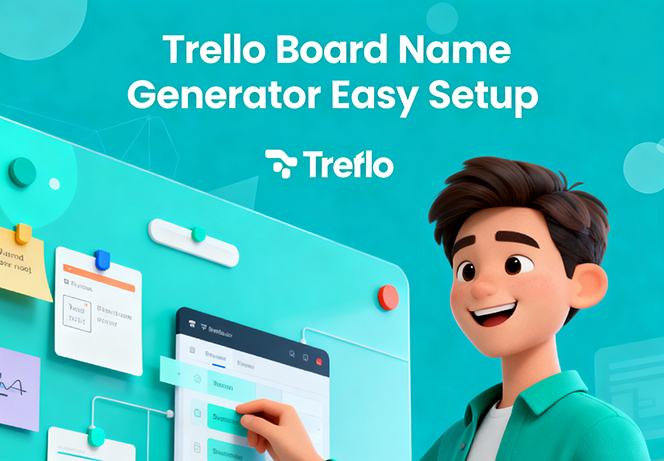Trello Board Name Generator Easy Setup

Want your Trello boards to actually speak to you at a glance? A smart, clear name cuts decision friction and makes boards feel lived-in — and that’s what this post is about. Below you’ll find 100 hand-picked Trello board names (grouped by style) with quick, plain-English meanings so you can pick one that fits — fast.
Trello Board Name Generator
Select a style and click the button to generate a unique Trello board name!
Why a good board name matters
A name is more than a label. It sets expectations for where cards go, who cares, and how urgent things are. Use a clear name and your team (or future you) will stop asking “Which board?” and start doing work.
Minimalist (clean, no-nonsense)
1. Inbox — Quick dump for new cards.
2. Next Up — What’s queued to start.
3. Doing — Active tasks, no frills.
4. Done — Finished items; quick wins.
5. Backlog — Ideas waiting for prioritization.
6. Now — What matters right now.
7. Archive — Old items kept for reference.
8. Weekly — This week’s priorities.
9. Today — Daily focus, refreshed each day.
10. Roadmap — Long-term plan at a glance.
Playful (light, friendly names)
11. Idea Garden — Where ideas grow and get pruned.
12. Rocket Fuel — High-energy tasks that move things fast.
13. Coffee Break — Small items you can finish in a coffee.
14. The Hive — Busy, collaborative work in progress.
15. Spark Plug — Quick wins that ignite momentum.
16. Happy Path — Smooth, low-friction tasks.
17. Cookie Jar — Rewards, treats, small celebrations.
18. Treasure Chest — Valuable ideas or assets.
19. Jigsaw — Pieces that need fitting together.
20. Bounce Room — For things that need feedback.
21. Stage Left — Items waiting in the wings.
22. Wildcards — Unexpected tasks or creative experiments.
23. Magic List — Things that feel like small miracles.
24. Bunny Trail — Explorations worth a short detour.
25. Monday Mojo — Start-the-week energy board.
Agile / Productivity (sprints, workflows)
26. Sprint Board — Current sprint scope and stories.
27. Kanban Flow — Visual workflow, from todo to done.
28. Standup Notes — Daily updates and blockers.
29. Priority Lane — Top-priority items only.
30. Bugs & Fixes — Issues to squash.
31. Release Prep — Steps before shipping.
32. Hotfix Queue — Urgent fixes, fast turnaround.
33. Retrospective — Team learnings and action items.
34. Epic Tracker — Big features broken down.
35. Roadblock Alley — Items waiting on decisions.
36. Capacity Plan — Who’s available this week.
37. Sprint Backlog — Committed sprint tasks.
38. Prod Ops — Production support and ops tasks.
39. Feature Lab — New feature experiments.
40. QA Ready — Items prepped for testing.
41. Deploy Watch — Releases and rollbacks.
42. Cycle Time — Monitor progress and flow.
43. Milestones — Major checkpoints and deadlines.
44. Cross-Functional — Work that spans teams.
45. Action Items — Clear tasks to execute now.
Creative & Brainstorming (freeform, idea-focused)
46. Brain Dump — All raw ideas, no editing.
47. Mood Board — Visual vibes and references.
48. Sketchpad — Quick creative drafts.
49. Collage — Mixed media and notes.
50. Copy Bank — Headline and text ideas.
51. Color Study — Palette and design choices.
52. Story Beats — Plot points or content flow.
53. Persona Lab — User profiles and notes.
54. Concept Kitchen — Mix and test new concepts.
55. Remix Room — Rework existing ideas.
56. Draftshelf — In-progress pieces not ready yet.
57. Muse List — Inspiration and bookmarks.
58. Prototype Alley — Early mockups and tests.
59. Voice Notes — Tone suggestions and lines.
60. Experiment Log — What we tried and what happened.
Personal & Life (home, habits, personal projects)
61. Home Base — Household to-dos and reminders.
62. Chore Chart — Daily and weekly chores.
63. Meal Plan — Recipes and shopping lists.
64. Budget Board — Bills, tracking, and goals.
65. Health Tracker — Workouts, appointments, meds.
66. Reading List — Books to read and notes.
67. Family Calendar — Events and shared plans.
68. Side Hustle — Small business or freelance work.
69. Renovation Plan — Home projects and milestones.
70. Life Goals — Big-picture milestones & dreams.
Events & Travel (planning and logistics)
71. Trip Planner — Routes, bookings, must-sees.
72. Party Prep — Guest list, supplies, timeline.
73. Conference Kit — Talks, contacts, follow-ups.
74. Wedding Board — Vendors, timeline, RSVPs.
75. Event Runbook — Day-of steps and roles.
76. Packing List — Essentials and backups.
77. Venue Search — Options and pros/cons.
78. Flight Watch — Tickets and schedule changes.
79. Itinerary — Daily plans and timings.
80. RSVP Tracker — Guest responses and needs.
Study & Learning (students, self-education)
81. Semester Map — Course plan and deadlines.
82. Assignment Hub — Due tasks and progress.
83. Revision Deck — Topics to review and practice.
84. Research Notes — Papers, quotes, sources.
85. Exam Countdown — Topics per week before test.
86. Reading Notes — Summaries and highlights.
87. Project Notebook — Research project steps.
88. Flashcards — Short facts to memorize.
89. Study Sprints — Focused study blocks.
90. Group Work — Shared tasks and meeting notes.
Team & Ops / Misc (cross-team, admin, one-offs)
91. Onboarding — New hire tasks and checklists.
92. Playbook — Standard procedures and tips.
93. Vendor List — Contacts and contracts.
94. Content Calendar — Scheduled posts and drafts.
95. Social Queue — Ready-to-post social items.
96. KPI Dashboard — Metrics to watch.
97. Legal & Docs — Contracts, approvals, OTAs.
98. Maintenance — Recurring upkeep tasks.
99. Feedback Loop — Collected feedback and actions.
100. Sprint Review — Outcomes and next steps.
Quick setup tips — make names work for you
Pick a style that matches your board’s tone (minimalist for operations, playful for creative).
Keep names short — 2–3 words read fastest.
Be consistent across boards so users know what to expect.
Use emojis sparingly to add context without noise (e.g., 📦 Archive).
If you use a generator (see placeholder above), add filters: style, length, topic.






